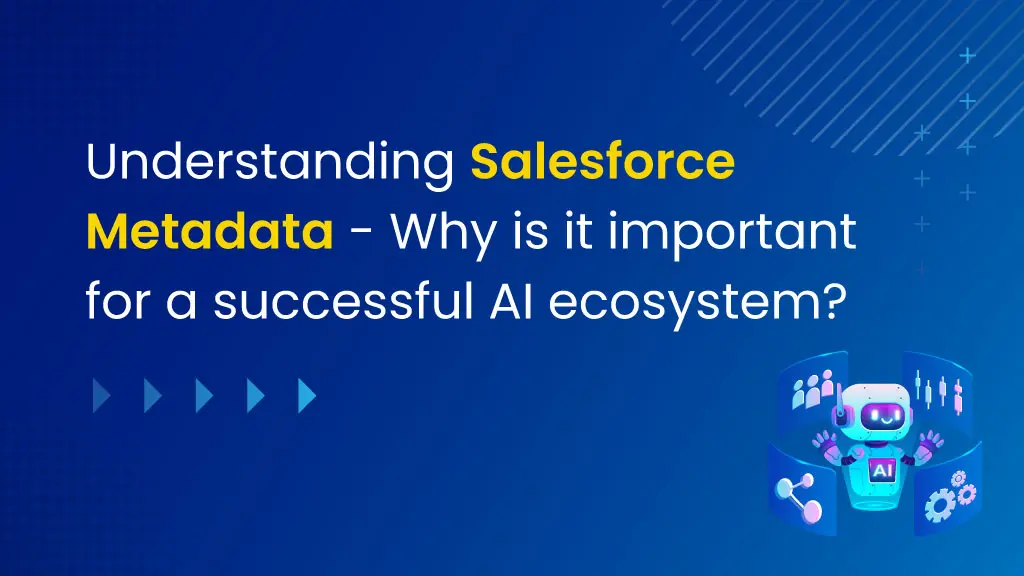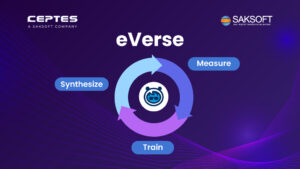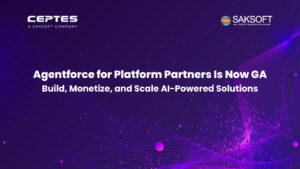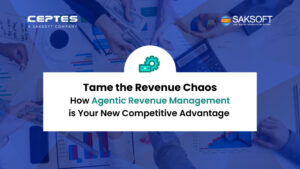When we talk about building intelligent AI systems, most conversations start with data. However, while data is essential, it’s metadata that gives it structure, meaning, and usability. Without metadata, data is just raw material — unorganized, inaccessible, and difficult for AI agents to interpret. In simple terms, metadata is “data about data”.
Imagine stepping into the grandest library in the world. Towering shelves stretch endlessly. Millions of books, documents, articles — but there’s a catch: none of it is organized. No labels, no categories, no sections. It will be difficult to find the book that you want, right? That’s what raw data looks like.
Now picture a brilliant librarian tagging every book with topics, authors, and last borrowed dates. It will be easier to find the book you need— fast. That librarian is metadata.
But what does metadata mean in Salesforce context?
What is Salesforce Metadata?
Salesforce metadata is the setup behind how your org works. It’s not your actual data, but the stuff that defines structure — like custom fields, page layouts, and automation rules. It’s not the data you enter (like customer names or sales numbers), but the instructions that tell Salesforce how to store, display, and process that data.
For example, when you create a custom field, design a page layout, or build a workflow rule — that’s all metadata. It defines what objects exist (like Accounts or Opportunities), how they’re connected, what users can see, and what happens when someone clicks a button – all based on your business needs. With metadata, Salesforce Admins see how the platform is built and make informed decisions when customizing or managing their org.
Types of Salesforce Metadata
Salesforce metadata comes in a few different types, each handling a different part of your org:
- Data – This is the foundation. It includes things like custom objects, picklists, and apps you build to fit your business needs.
- Programmability – This covers custom logic, like Flows, Apex classes, and triggers. It’s how you automate tasks, build custom logic, and extend Salesforce capabilities beyond what’s available.
- Presentation – This is all about what users see. It includes Lightning pages, components, and Visualforce pages that shape the user experience.
- Custom Metadata Types – These let you create your own metadata for things like rules, mappings, or stored values. Think of it as building reusable settings that make complex customizations easier.
How does Metadata make AI better?
Metadata is what helps AI understand data — not just read it but truly make sense of it. For large language models (LLMs) and AI agents, metadata is like a roadmap that makes data easier to find, understand, and act on. In enterprise AI, metadata plays a bigger role. It defines what autonomous AI agents can do (capabilities), how they talk to other systems (interfaces), and the environment they operate in (context). This framework helps businesses deploy AI agents smartly — whether it’s for answering customer questions, managing inventory, or running workflows.
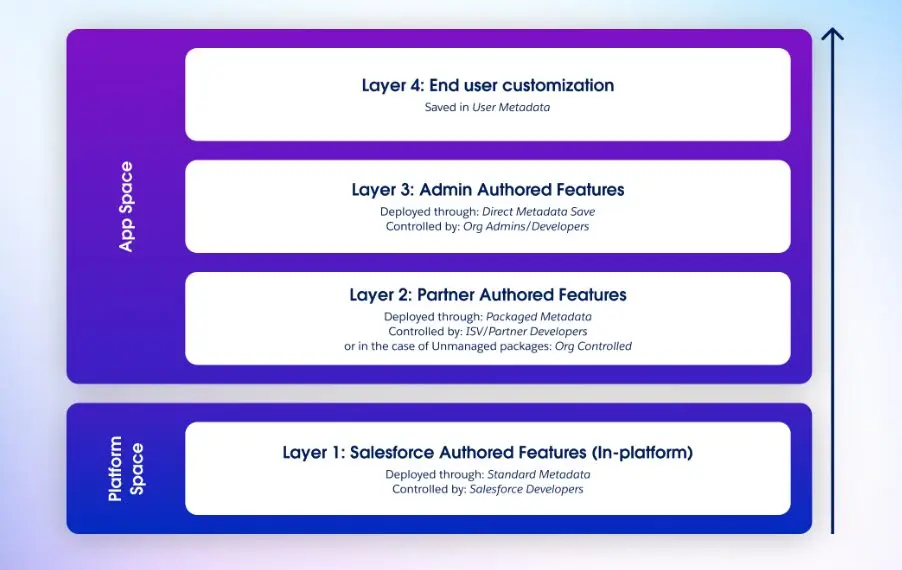
Here’s how metadata plays a key role in building a smart, scalable AI agent ecosystem:
1. Abstraction for Flexibility:
Metadata acts like a smart layer between AI and complex backend systems. It hides the technical mess and lets AI agents evolve without rewriting code every time something changes. That’s why Salesforce apps, built years ago, still run smoothly today— as the metadata framework also evolved dynamically to support new data types, entities, and relationships without disrupting existing systems.
2. Standardization for Agent Collaboration:
AI agents aren’t meant to work alone—they need to share data, learn from each other, and make decisions together. A standardized metadata structure ensures they all speak the same language. With shared models and formats, agents can communicate seamlessly and work as a team.
3. Structure for Better Understanding:
When metadata is well-organized, both humans and machines can understand it easily. In Salesforce, for example, every object, field, and label has structured metadata. This helps AI agents quickly grasp what data is, how it behaves, and how to use it—without needing complex code.
4. Strongly typed Metadata for Accuracy:
Strongly-typed metadata enforces a predefined structure for how data is represented and interacted with—using well-defined entities, fields, and records. In Salesforce, this is implemented through Object metadata, where every entity (like Account or Product) is modeled with precise data types, API names, and access rules. Rather than accessing raw, unstructured data, AI agents interact via the Salesforce Object APIs (sObjects) and SOQL (Salesforce Object Query Language). This abstraction ensures a consistent and predictable schema, which is critical for building dependable AI behaviors.
Salesforce Metadata GPT by CEPTES – For Smarter Metadata Management:
Metadata GPT is an advanced solution built to empower Salesforce developers and admins with smarter, faster, and more intuitive metadata management. From discovery to impact analysis, this tool streamlines every step of your metadata journey — all backed by the power of AI.
Metadata Generation & Management
Easily create, edit, and manage Salesforce metadata without writing complex code. Metadata GPT simplifies the creation of custom objects, fields, flows, and other components by auto-generating definitions based on your input.
Metadata Query, Dependency & Impact Analysis
Understand how metadata components relate to each other. The tool helps you query metadata and visualize dependencies — ensuring that changes don’t accidentally break automations, reports, or user experiences. Spot conflicts and assess the impact before making changes.
Metadata Modeling
Visualize your metadata structures and relationships like never before. Metadata GPT creates dynamic diagrams to help you grasp how objects, fields, automations, and layouts are connected — making it easier to plan customizations, onboard new team members, or debug issues.
With Metadata GPT, CEPTES brings clarity, control, and speed to Salesforce metadata — unlocking a new level of productivity for teams.
Practical Use Cases:
Salesforce isn’t a one-size-fits-all platform — and that’s what makes it powerful. Thanks to its metadata-driven flexibility, businesses across industries can shape Salesforce to match their unique needs. Let’s look at some of the industry use cases:
E-commerce & Retail: Smoother Shopping Experiences
For fast-growing online brands, customer experience is everything. With Salesforce metadata and automation, they can create custom workflows — like sending a thank-you email after a purchase or kicking off a return process as soon as a request is made. It’s not just about saving time; it’s about making every interaction feel seamless and personalized.
Financial Services: Secure, Timely Communication
In banking and finance, data privacy and timely client interactions are non-negotiable. Salesforce helps by automating alerts for financial milestones (like investment maturity dates), while metadata-based field-level security ensures only the right people see sensitive data. The result? Better service and strong data governance.
Manufacturing: Smarter Supply Chain Management
Manufacturers often deal with complex logistics and tight timelines. Salesforce can be configured to send alerts when inventory drops too low or when a supplier changes delivery dates. These customizations are driven by metadata and help prevent delays, keeping operations running smoothly.
Conclusion:
With 93% of enterprise IT leaders already using or planning to use AI agents in the next two years, the demand for scalable, flexible platforms is surging. Salesforce’s metadata framework rises to this challenge with a layered extension model on a deeply unified platform. It’s what enables developers, admins, and partners to innovate without limits, turning complex customization into simple configuration. The result? A thriving AI-powered ecosystem where agility meets intelligence. For forward-thinking enterprises, tapping into this potential isn’t optional — it’s the next leap in digital transformation. And at CEPTES, we’re helping you lead that leap.
Need consultation on Salesforce Metadata management? Reach out to us.
FAQ:
1. What is Salesforce Data Cloud used for?
2. How does Salesforce Data Cloud improve marketing ROI?
3. What are the key benefits of Salesforce Data Cloud?
4. Can Salesforce Data Cloud be integrated with existing Salesforce products?
5. How can businesses measure the ROI of Salesforce Data Cloud?

Nilamani Das
Nilamani is a thought leader who champions the integration of AI, Data, CRM and Trust to craft impactful marketing strategies. He carries 25+ years of expertise in the technology industry with expertise in Go-to-Market Strategy, Marketing, Digital Transformation, Vision Development and Business Innovation.















